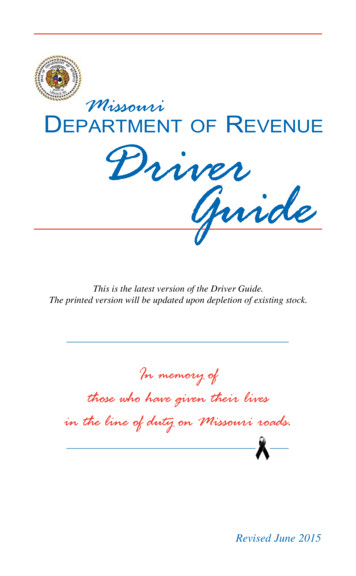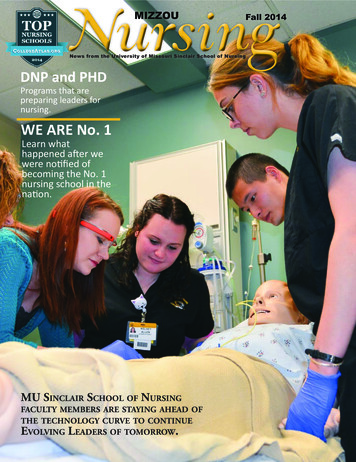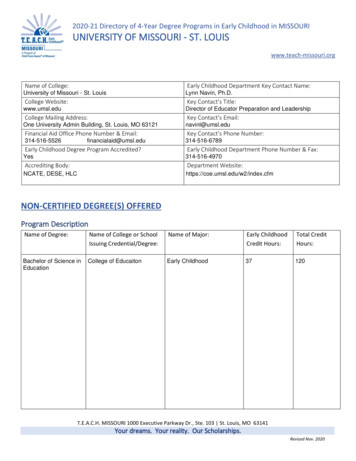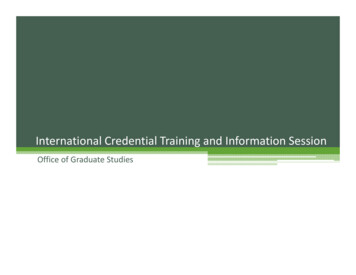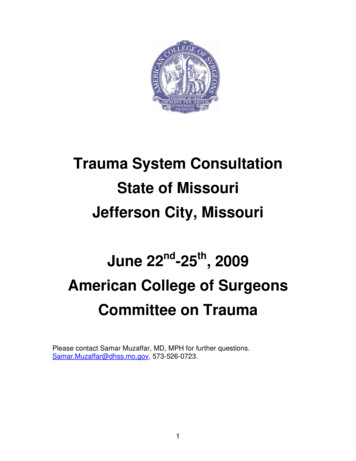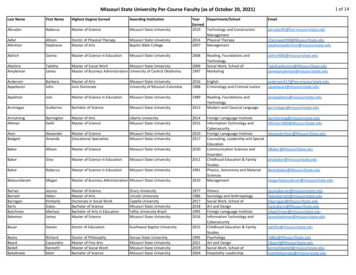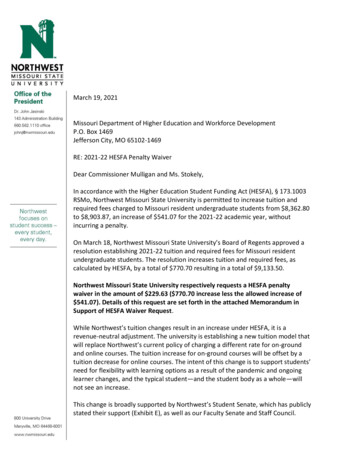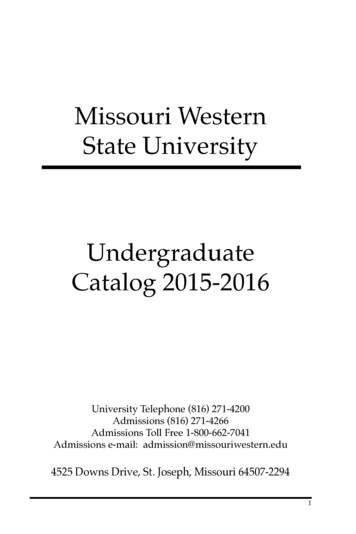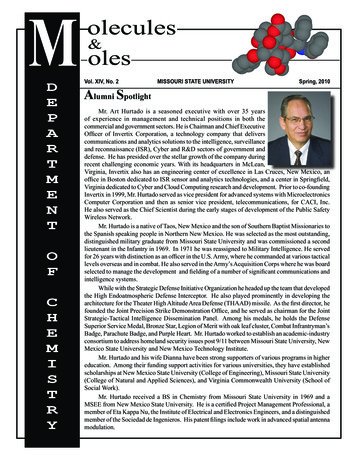
Transcription
MDEPARTMENTOFCHEMISTRYolecules&olesVol. XIV, No. 2Alumni SpotlightMISSOURI STATE UNIVERSITYSpring, 2010Mr. Art Hurtado is a seasoned executive with over 35 yearsof experience in management and technical positions in both thecommercial and government sectors. He is Chairman and Chief ExecutiveOfficer of Invertix Corporation, a technology company that deliverscommunications and analytics solutions to the intelligence, surveillanceand reconnaissance (ISR), Cyber and R&D sectors of government anddefense. He has presided over the stellar growth of the company duringrecent challenging economic years. With its headquarters in McLean,Virginia, Invertix also has an engineering center of excellence in Las Cruces, New Mexico, anoffice in Boston dedicated to ISR sensor and analytics technologies, and a center in Springfield,Virginia dedicated to Cyber and Cloud Computing research and development. Prior to co-foundingInvertix in 1999, Mr. Hurtado served as vice president for advanced systems with MicroelectronicsComputer Corporation and then as senior vice president, telecommunications, for CACI, Inc.He also served as the Chief Scientist during the early stages of development of the Public SafetyWireless Network.Mr. Hurtado is a native of Taos, New Mexico and the son of Southern Baptist Missionaries tothe Spanish speaking people in Northern New Mexico. He was selected as the most outstanding,distinguished military graduate from Missouri State University and was commissioned a secondlieutenant in the Infantry in 1969. In 1971 he was reassigned to Military Intelligence. He servedfor 26 years with distinction as an officer in the U.S. Army, where he commanded at various tacticallevels overseas and in combat. He also served in the Army’s Acquisition Corps where he was boardselected to manage the development and fielding of a number of significant communications andintelligence systems.While with the Strategic Defense Initiative Organization he headed up the team that developedthe High Endoatmospheric Defense Interceptor. He also played prominently in developing thearchitecture for the Theater High Altitude Area Defense (THAAD) missile. As the first director, hefounded the Joint Precision Strike Demonstration Office, and he served as chairman for the JointStrategic-Tactical Intelligence Dissemination Panel. Among his medals, he holds the DefenseSuperior Service Medal, Bronze Star, Legion of Merit with oak leaf cluster, Combat Infrantryman’sBadge, Parachute Badge, and Purple Heart. Mr. Hurtado worked to establish an academic-industryconsortium to address homeland security issues post 9/11 between Missouri State University, NewMexico State University and New Mexico Technology Institute.Mr. Hurtado and his wife Dianna have been strong supporters of various programs in highereducation. Among their funding support activities for various universities, they have establishedscholarships at New Mexico State University (College of Engineering), Missouri State University(College of Natural and Applied Sciences), and Virginia Commonwealth University (School ofSocial Work).Mr. Hurtado received a BS in Chemistry from Missouri State University in 1969 and aMSEE from New Mexico State University. He is a certified Project Management Professional, amember of Eta Kappa Nu, the Institute of Electrical and Electronics Engineers, and a distinguishedmember of the Sociedad de Ingenieros. His patent filings include work in advanced spatial antennamodulation.
He is currently a member of the Board of Visitors forVirginia Commonwealth University, and he is currentlyserving as the President of the Board of Trustees for theVCU College of Engineering. He was a charter memberin the formation of the Advisory Board for New MexicoState University’s College of Engineering, and the KlipschElectrical and Computer Engineering Academy in 1991.He continues to serve on both. In 2003 he guided theformation of the Advisory Board for the Department ofChemistry, MSU, on which he currently serves. He isalso a member of the Advisory Board for the School ofInformation Technology and Engineering, George MasonUniversity.Mr. Hurtado is an active member of the PotomacOfficer’s Club and a frequent speaker in various industryand academic forums. He is currently pursuing a Mastersof Theology at Capital Bible Seminary in Lanham, MD.His wife, Dianna, a licensed clinical psychotherapist,holds a MSW from VCU. In 1971 they adopted Virginiaas their home and currently reside in Fairfax.college by cuts in general programs and by encouragingretirements, none of which are coming from Chemistry.Thus, through the next academic year our department isfortuitously evading any significant budget reductions.Predictions for 2011-12, however, indicate cuts in highereducation could be as much as an additional 15% . Witha little more “belt tightening” at the university level anda few more retirements, this cut might translate to about11% to our college. If that happens, no department willremain untouched. Starting in the fall, more definitivebudget values will begin to develop that may very wellrequire us to reexamine how we do business, so keep yourfingers crossed.FACULTY NEWSRichard Biagioni, Chuck Rovey, and Doug Gouziereceived a grant from The U.S. Department of Energy,NETL, for 2009, for the project entitled, “Monitoring andNumerical Modeling of Shallow CO2 Injection,” GreeneCounty, Missouri, in the amount of 293,117.Mark M. Richter co-authored a paper with NiallS. Pennington and Brenden Carlson entitled, “EfficientElectrogenerated chemiluminescence from Osmium(II)Polypyridine Systems Containing Tetraphenylarsine orDiphenylphosphine Ligands,” Dalton Trans., 2010, 39,1586–1590. He received a Missouri State UniversityFaculty Research Grant for Spring, 2010, for the project“Enhancing Light-Emission Using Carbon Nanotubes,”in the amount of 5,696.Nikolay Gerasimchuk co-authored a paperwith A. N. Esaulenko, K. N. Dalley and C. Mooreentitled, “2-Cyano-2-isonitroso Acetamide and its Ag(I)Complexes. Silver(I) Cyanoximate as a Non-electric GasSensor,” Dalton Transactions, 2010, 39, p.749-764. JeffMorton presented, “Silver(I) Cyanoximates: Synthesis,Crystal Structures, and Physical Properties,” co-authoredwith N. Gerasimchuk, at the national ACS meeting in SanFrancisco, CA, in March 2010.NOTE FROM THE HEAD - Dr. Alan SchickI have truly enjoyed myfirst year at MSU. I find that thefaculty and staff function ratherwell as a team and manageto accomplish a broad rangeof activities that could notpossibly be achieved by anysmaller of a group. Our majorsstrike me as being motivated,focused, and determined, and once again we had a greatgroup of award winners at our annual banquet.As you look through this issue of M&M you willnote many accomplishments of our faculty, students,and alumni. Several publications are already in printfrom our department in 2010, and a number of othershave been accepted; our students showed well at the 1stAnnual CNAS Undergraduate Research Day; alumni aremoving up all around the region and the country; and ourfaculty continue to provide international exposure for ourdepartment. Dr. Richter is coming up to the second of atleast three consecutive summers of conference invitationsabroad (China in 2009, Australia in 2010, and very likelyback to China in 2011), and “Dr. G” just got back from avery unique and productive sabbatical in Germany.On a more somber note, you may be seeing andhearing news of Missouri’s budget situation and itseffect on higher education in the state, particularlyregarding MSU. At this point the university is lookingat a modest 5.1% budget reduction for 2010-11, whichis effectively being absorbed by the university and theJeffrey MortonReza Herati received a Missouri State UniversitySummer Faculty Fellowship for 2010 for the project,-2-
“Synthesis of Linear Poly(ethylene glycol)-blockPoly(ether-sulfide) Dendritic Polymers and TheirApplications in Drug Delivery,” in the amount of 6000.Adam Wanekaya was co-author on the followingpublications: (1) S. Tolani, A. Mugweru, M. Craig, andA. K. Wanekaya, “Rapid and Efficient Removal of HeavyMetal Ions from Aqueous Media Using Cysteine-modifiedPolymer Nanowires,” Journal of Applied PolymerScience, 2010, 116, 308-313. (2) N. Havens, D. Kim,M. Luna, A. Mugweru, and A. K. Wanekaya, “RedoxPolymer Covalently Modified Multiwalled CarbonNanotube Based Sensors for Sensitive Acetaminophenand Ascorbic Acid Detection,” Electrochimica Acta, 2010,55, 2186-2190.mountains in Baden-Wurtenberg land. Here is the oldestuniversity in Europe: it was founded in 1386. Theuniversity’s logo is very symbolic Semper Apetus! - Thebook of knowledge is always open! It is one of the bestGerman universities for all disciplines and programs, andactually has the best Physics Department in the country.Brilliant minds worked here: August Kekule (theoryof valence of chemical elements and carbon in particular;origin of the cyclic nature of benzene), Robert Bunzen(invention of the burner, discovery of Cs and Rb),Victor Meyer (the Meyer reaction), Emil Knövenagel(Knevenagel’s condensations), Theodor Curcius (firstpreparation of semiconductor grade pure silicon), LeopoldGmelin (first classification of inorganic compounds andminerals – first handbook on a subject!). The ChemistryDepartment has three units and fields of specialization-inorganic, organic, physical and colloidal chemistry. Theteaching process, such as general lectures and seminars,are carried out in a small separate building. All teachinglabs and research laboratories are located in three adjacent,spacious buildings, which are Inorganic, Organic andPhysical Chemistry Institutes; Biochemistry belongs to theBiology Department. The Inorganic Chemistry Institute hasfour active professors and three emeritus professors, one ofwhom still regularly conducts research. Professors teachlarge classes in Inorganic Chemistry--General Chemistry,Inorganic Chemistry, Organometallic Chemistry,Qualitative Analytical Chemistry, Quantitative AnalyticalChemistry, Bioinorganic Chemistry, SpectroscopicMethods, Synthesis and Characterization of Inorganicand Organometallic Compounds. Every professor has asecretary and two to three habilitants (Research Professors)who after their PhD work in the area of the professor’sinterest and provide significant teaching assistance tohim. They also recruit/train/supervise undergraduateand graduate PhD students. Without habilitants all theprofessors’ work in teaching and research would simplycollapse. All habilitants work three–five years with theirCHEMISTRY PROFESSORTO PRESENT KEYNOTELECTURE AT THE 13THROYAL AUSTRALIANCHEMICAL INSTITUTE(RACI) CONVENTION INMELBOURNE, AUSTRALIADr. Mark Richter has been invited to present akeynote lecture at the 13th Royal Chemical Institute’s(RACI) Convention. The conference will be held July4-8, 2010 in Melbourne, Australia. The theme of thisconference is Measurement and Sustainability. Dr.Richter is actively involved in chemical research in thefield of light emitting systems. He will be discussingongoing work in his group to improve light emissionfrom chemical systems, and the use of these systems todetect various chemicals of interest (e.g., pollutants andmolecules important in medical diagnostics).Dr. Richter has also been invited to present at the21st Biennial Conference on Chemical Education (BCCE)Conference. The meeting will be held August 1-5, 2010at the University of North Texas in Denton. He will bepresenting in the “Out of the Box: Teaching Chemistrywith Case Studies and Applications” symposium. Dr.Richter attended a workshop in 2005 on using CaseStudies to improve student learning, and has incorporatedCase Studies into both lower and upper division chemistrycourses.SABBATICAL IN EUROPE: WORK AND LIFEIN HEIDELBERG, GERMANY--By Dr. NikolayGerasimchukFrom August 4 until December 21 of 2009, I livedand worked in the small German university town ofHeidelberg with a population of 100,000 and locatedon the Neckar River in a picturesque valley between-3-
chosen professor/adviser on a research project of mutualinterest and eventually present their Doctor of ScienceDissertation.The process ofits internal andexternal analysis/confirmationtakes aboutone year, afterwhich habilitantsare lookingfor permanentp o s i t i o n sthemselves.I workedin the ResearchGroupofProfessor RoaldKrämer, whomI met during myfirst visit to Heidelberg for the International Conferenceon Coordination Chemistry (ICCC-35) the summer of2002. He is a known expert in the field of BioinorganicChemistry of DNA and RNA, metalloproteins. Todayhe is a Director of the Inorganic Chemistry Institute.The research group had six spacious labs with manyundergraduate and Ph.D. students. My immediate hostin Krämer’s research group was the Group Leader Dr.Andrew Mokhir. I have known him since 1990 whenhe had just entered as an undergraduate student atKiev State University in Ukraine. I was his InorganicChemistry teacher at that time, and he later joined myresearch group. We also worked together in the lab ofProf. Kenton Rodgers at North Dakota State Universityfrom 1997-1998. Dr. Mokhir was solely responsiblefor my accommodation, laboratory research space andrelated spending. He gave me a small, but well equippedsynthetic research laboratory in which I worked alone.While still here at Missouri State, we extensivelydiscussed a mutually interesting research project. Weinvestigated three conceptual ideas: 1) the use of thesynthetic 14-mer cyclic DNA molecules as templatesfor possible crystallization of initially centrosymmetriccrystals into chiral/non centrosymmetric space groups; 2)study of interactions of heterocyclic cyanoximes and theirPt-complexes with the DNA – 15-mer double-strandedoligomers and 25/35 doble-/single-stranded DNA; 3)preparation of a series of highly colored low-spin Fe(II)tris-cyanoximates for their comprehensive spectroscopicand Mössbauer effect characterization. In July of 2009prior to my departure for Germany, I sent several parcelswith initial compounds and cyanoxime ligands. Whilewaiting for the compounds to arrive, I wrote and submittedtwo papers for publication (both already published).My DNA experiments, despite the effort and significantcost ( 5,000 perDNA sample),unfortunately didnot produce theexpected results.Nevertheless, Ihave learned firsthand how to workwith DNA duringmy Pt-binding andother studies, andthis experiencedefinitely willbe very usefulfor the plannedcontinuation ofrelated work here.The third projectwas a complete success: ten new compounds weremade, characterized and submitted for 57Fe Mössbauerstudies at the Laboratory of Nuclear Chemistry ofBudapest University. I expect this work to be readyfor publication soon. Besides my synthetic work inHeidelberg I have established good personal contact withlocal crystallographers – Dr. Frank Röminger and Dr.Huber Wadepohl. I learned quite a bit during our longconversations on the topic of disorder and using restraintsduring the final stages of crystal structure refinements.This knowledge is very helpful now since I encountermany disordered structures these days while working onour APEX 2 diffractometer.During my sabbatical I had three unforgettablelecture tours--Poland (Wroclaw, two lectures), Hungary(Szeged, Pecs, Debrecen, Budapest – four lectures), andEngland (Hull, one lecture)--about my research that wascarried out at MSU.ALUMNUS ON THE MOVE(UT-Dallas Press Release)Dr. Dennis W. Smith Jr., hasjoined the University of Texas atDallas as professor and holder ofthe Robert A. Welch Chair in Chemistry. The WelchFoundation is a philanthropic organization that supportsfundamental chemical research in Texas.Dr. Smith is an expert on fluorine-containing polymersand renewable-resource and biodegradable materials. Thematerials include long-chain macromolecules that makeup films, coatings, rubber, membranes, plastics and othermaterials. Some have been tested for use on future Space-4-
Melissa N. Hayes, Gary Meints, “DNA RepairProtein Expression: Pyrimidine Dimer Glycosylase Codedby Cholrella Virus PBCV-1.”Shuttle missions and in hydrogen-powered fuel cellvehicles.His research in micro-optics—using light ratherthan electricity to communicate and process energy—hasthe potential to double storage space on DVDs and lightenthe weight of military aircraft.Before coming to UTD, Dr. Smith was professorof chemistry and material science and engineering atClemson University. Prior to his academic career, he wasa senior research chemist and a project leader with TheDow Chemical Company.Dr. Smith co-founded Tetramer Technologies,LLC, which employs 25 chemists and engineers in SouthCarolina. He is listed as co-inventor on 14 U.S. patents, sixof which are under commercial license. His publicationsinclude 100 refereed papers (published or in press) andtwo book editorships.Dr. Smith received a BS in chemistry andmathematics from Missouri State University in 1988 and aPhD in chemistry from the University of Florida in 1992.Melissa HayesFALL 2009 GRADUATESBS Degree:Varsin AminRoss BlackshearsJohn BledsoeDaniel BrownJustin HarperGary HerronCNAS UNDERGRADUATE RESEARCH DAYWithin the Chemistry Division, Melissa Hayesreceived the 1st Place award in the amount of 100, andRyan Spidle received the 2nd Place award in the amountof 50.Matthew KeeneKanako KuramochiChad PepmillerStephannie TaggartEmily WilsonALUMNI NEWSLisa Calvin Blue (BS ‘98; MS ‘02) has moved backto Lexington, Kentucky, to run a start-up company. Sheis Director of Development for Merloc, LLC. She will beworking to begin industrial-scale production and sales of aclass of metal, chelation compounds with applications indrinking water treatment and environmental remediation(acid mine drainage, coal-fired power plants, lead batteryrecycling effluents and the like).Michael Bollinger (BS ‘76), Masters of Public Healthin Environmental and Occupational Health from St. LouisUniversity. He presently holds the position of PrincipalEnvironmental Scientist at Ameren in St. Louis.Lance Christie (BS ‘96) is living in Nevada,Missouri, and is a Sr. Process/Product Engineer with 3M.He previously lived in St. Louis, Missouri, and completedan MBA at Washington University while there. In additionto his position at 3M, Lance has three children and alsoteaches at Crowder College.Joseph Ellsworth (BS ‘04) is currently workingon a law degree at Oklahoma City University School ofLaw and will graduate in Spring, 2011. He also holds aPhD in Inorganic Chemistry from the University of SouthCarolina.Pazong VangAshley Egan, Pazong Vang, Bhaskar Datta,“Thermoreversible Association of Nucleic Acids intoSupramolecular Aggregates.”Amos Hale, Gary Meints, “Investigation of theFunction of DNA Base Repair Proteins Using Solid-State2H NMR.”J. Mark Hobbs, Niral Patel, Daniel Kim and AdamWanekaya, “Carbon Nanotube-based Glucose Biosensorfor the Undergraduate Laboratory.”Ryan Spidle, Charles C. Chusuei, KartikGhosh, Robert DeLong and Adam Wanekaya, “ZincOxide Nanoparticles: Hydrothermal Synthesis andCharacterization.”-5-
olecules oles D Vol. XIV, No. 2 MISSOURI STATE UNIVERSITY Spring, 2010 E P A R T M E N T O F C H E M I S T R Y M Alumni Spotlight Mr. Art Hurtado is a seasoned executive with over 35 years of experience in management and technical positions in both the
